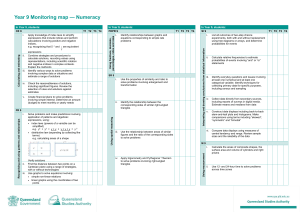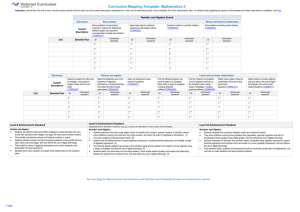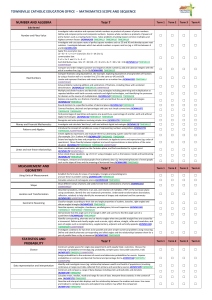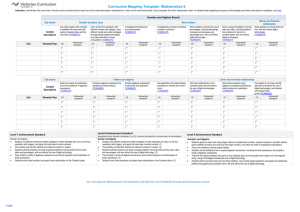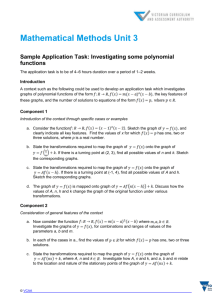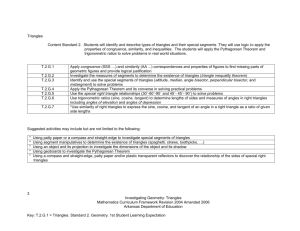Year 9 - Calculate
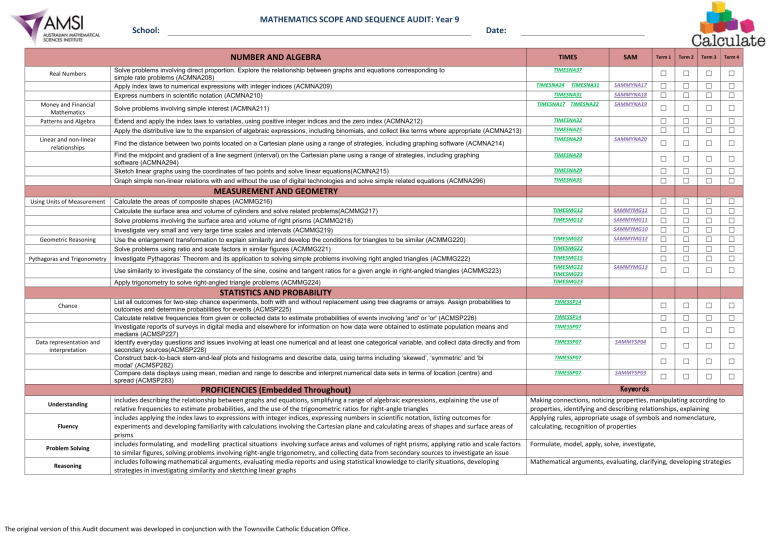
School:
MATHEMATICS SCOPE AND SEQUENCE AUDIT: Year 9
Date:
NUMBER AND ALGEBRA
Real Numbers
Money and Financial
Mathematics
Patterns and Algebra
Linear and non-linear relationships
Solve problems involving direct proportion. Explore the relationship between graphs and equations corresponding to simple rate problems (ACMNA208)
Apply index laws to numerical expressions with integer indices (ACMNA209)
Express numbers in scientific notation (ACMNA210)
Solve problems involving simple interest (ACMNA211)
Extend and apply the index laws to variables, using positive integer indices and the zero index (ACMNA212)
Apply the distributive law to the expansion of algebraic expressions, including binomials, and collect like terms where appropriate (ACMNA213)
Find the distance between two points located on a Cartesian plane using a range of strategies, including graphing software (ACMNA214)
Find the midpoint and gradient of a line segment (interval) on the Cartesian plane using a range of strategies, including graphing software (ACMNA294)
Sketch linear graphs using the coordinates of two points and solve linear equations(ACMNA215)
Graph simple non-linear relations with and without the use of digital technologies and solve simple related equations (ACMNA296)
MEASUREMENT AND GEOMETRY
Using Units of Measurement Calculate the areas of composite shapes (ACMMG216)
Geometric Reasoning
Calculate the surface area and volume of cylinders and solve related problems(ACMMG217)
Solve problems involving the surface area and volume of right prisms (ACMMG218)
Investigate very small and very large time scales and intervals (ACMMG219)
Use the enlargement transformation to explain similarity and develop the conditions for triangles to be similar (ACMMG220)
Solve problems using ratio and scale factors in similar figures (ACMMG221)
Pythagoras and Trigonometry Investigate Pythagoras’ Theorem and its application to solving simple problems involving right angled triangles (ACMMG222)
Chance
Data representation and interpretation
Understanding
Fluency
Problem Solving
Reasoning
Use similarity to investigate the constancy of the sine, cosine and tangent ratios for a given angle in right-angled triangles (ACMMG223)
Apply trigonometry to solve right-angled triangle problems (ACMMG224)
STATISTICS AND PROBABILITY
List all outcomes for two-step chance experiments, both with and without replacement using tree diagrams or arrays. Assign probabilities to outcomes and determine probabilities for events (ACMSP225)
Calculate relative frequencies from given or collected data to estimate probabilities of events involving 'and' or 'or' (ACMSP226)
Investigate reports of surveys in digital media and elsewhere for information on how data were obtained to estimate population means and medians (ACMSP227)
Identify everyday questions and issues involving at least one numerical and at least one categorical variable, and collect data directly and from secondary sources(ACMSP228)
Construct back-to-back stem-and-leaf plots and histograms and describe data, using terms including ‘skewed’, ‘symmetric’ and ‘bi modal’ (ACMSP282)
Compare data displays using mean, median and range to describe and interpret numerical data sets in terms of location (centre) and spread (ACMSP283)
PROFICIENCIES (Embedded Throughout)
includes describing the relationship between graphs and equations, simplifying a range of algebraic expressions, explaining the use of relative frequencies to estimate probabilities, and the use of the trigonometric ratios for right-angle triangles includes applying the index laws to expressions with integer indices, expressing numbers in scientific notation, listing outcomes for experiments and developing familiarity with calculations involving the Cartesian plane and calculating areas of shapes and surface areas of prisms includes formulating, and modelling practical situations involving surface areas and volumes of right prisms, applying ratio and scale factors to similar figures, solving problems involving right-angle trigonometry, and collecting data from secondary sources to investigate an issue includes following mathematical arguments, evaluating media reports and using statistical knowledge to clarify situations, developing strategies in investigating similarity and sketching linear graphs
TIMES SAM Term 1 Term 2 Term 3 Term 4
TIMESNA37
☐
TIMESNA24 TIMESNA31 SAMMYNA17 ☐
TIMESNA31 SAMMYNA18 ☐
TIMESNA17 TIMESNA22 SAMMYNA19
☐
TIMESNA32
TIMESNA25
TIMESNA29 SAMMYNA20
☐
☐
☐
TIMESNA29
TIMESNA29
TIMESNA35
TIMESMG12
TIMESMG12
TIMESMG22
TIMESMG22
TIMESMG15
TIMESMG22
TIMESMG23
TIMESMG23
TIMESSP14
☐
☐
☐
☐
SAMMYMG11 ☐
SAMMYMG11 ☐
SAMMYMG10 ☐
SAMMYMG12 ☐
☐
☐
SAMMYMG13
☐
TIMESSP14
TIMESSP07
☐
☐
☐
TIMESSP07 SAMMYSP04
☐
☐
☐
☐
☐
☐
☐
☐
☐
☐
☐
☐
☐
☐
☐
☐
☐
☐
☐
☐
☐
☐
☐
☐
☐
☐
☐
☐
☐
☐
☐
☐
☐
☐
☐
☐
☐
☐
☐
☐
☐
☐
☐
☐
☐
TIMESSP07
☐ ☐ ☐ ☐
TIMESSP07 SAMMYSP03
☐ ☐ ☐
Keywords
Making connections, noticing properties, manipulating according to properties, identifying and describing relationships, explaining
Applying rules, appropriate usage of symbols and nomenclature, calculating, recognition of properties
☐
☐
☐
☐
☐
☐
☐
☐
☐
☐
☐
☐
☐
☐
☐
☐
☐
☐
☐
☐
☐
☐
☐
Formulate, model, apply, solve, investigate,
Mathematical arguments, evaluating, clarifying, developing strategies
The original version of this Audit document was developed in conjunction with the Townsville Catholic Education Office.
